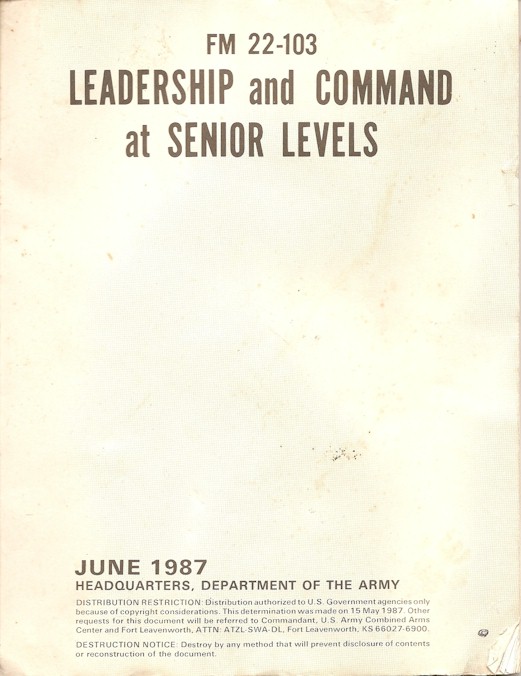Introduction
This post is the fourth part of a ramble-rant about the software business. The first post is entitled Goodwill, Negative and Positive; the second, Visions, Quests, Missions; the third, Right, Wrong, and Style.
Lead, Follow, or Get Out of the Way
There are a lot of interesting books out there on leadership. I still use this one:

This my tattered copy, the one I received as an attendee of the Virginia Army National Guard Non-Commissioned Officer Academy. Most leadership books aren’t a matter of life and death, or the future of a nation. This one is about those things.
Each chapter starts with a quote from a military leader. You may be surprised to find concepts that apply to leading a software project in these pages (or you may not be surprised, I suppose it depends on your background). For example, Chapter 1’s quote is:
Wars may be fought by weapons, but they are won by men. It is the spirit of the men who follow and the man who leads that gains victory. – General George S. Patton, Jr.
To me, that quote says some of the same things I was trying to say about teams and leaders in Visions, Quests, Missions. This book is chock full of leadership goodies that can be applied by anyone who finds themselves in a leadership role:
- Managers
- Directors
- User Group Leadership
- Team Leads
- Consultants in a Project / Technical Lead role
“Go Do That”
I used to work for a living; nowadays I think and type. There’s a difference. Work hurt my back, and sometimes my arms and legs too. Before joining the software community, I held a bunch of different jobs. I’ve been a truck driver, peach picker, tobacco puller, soldier (part-time), factory laborer and electrician, electronics technician, electrical engineer, and farm hand – to name a few. Most of those jobs involved work.
A lot of my bosses were go-do-that bosses. They would point to something – a row of tobacco, a stand of peach trees, a pile of manure, the perfect location for a foxhole – and say something like “Leonard! Take care of that.” It was my job to go do the work. It was their job to tell me which work needed to be done.
It wasn’t very collaborative, this go-do-that style of leadership. But some quests and missions require this style of leadership.
You hear a lot of talk about motivating people in the go-do-that style of management. You don’t hear a lot about inspiring them.
“Follow Me”
Other bosses jumped into the trenches (or code, or foxholes) with those they led. These were follow-me leaders. They got out front. They physically led. If I worked on a weekend, these bosses would usually show up too – not every weekend and not for the whole day – but they made an appearance and gave up some of their time alongside the team.
I think this style of leadership works better. Why? Nothing builds loyalty like a leader out front. And when the team (or squad or family) is out of magic – when the deadline looms or more enemy troops than expected show up – you need something beyond talent or training. Loyalty will help.
I find follow-me leadership to skip right past motivating people and into inspiring them.
Conclusion
The follow-me leadeship style instills loyalty better than anything I know. It’s inspiration instead of motivation, and inspiration will always take you farther.
:{> Andy

Andy,
Right on, brother!
I have been in IT for a while now and continue to be amazed the lack of basic awareness of leadership concepts that I learned in the Navy when I was 19 years old.
This one is most apparent and common:
"Never criticize a subordinate in public."
Far too often in IT shops I can overhear IT "leaders" sniping away over petty internal political rivalries within earshot of those they supposedly lead.
Take a few simple tips I learned from the US Navy:
"Never criticize a subordinate in public."
"Always be positive in private criticism."
"Work smarter, not harder."
These work for the USN, they’ll work for you.
Chuck
Hallelujah!
"L’audace! L’audace! Tujours l’audace!" — Gen Patton
This method is also very effective when it comes to getting my kids to do chores. We kind of do them as a collaborative effort (at least to get them started). I generally go in and help for a few minutes – make it apparent what the overall goal is and then move on to the next task. The kids seem to finish the chores much more quickly and with much less whining, arguing and attitude 🙂
So – um yeah IT Profs are a lot like kids – but we knew this already!